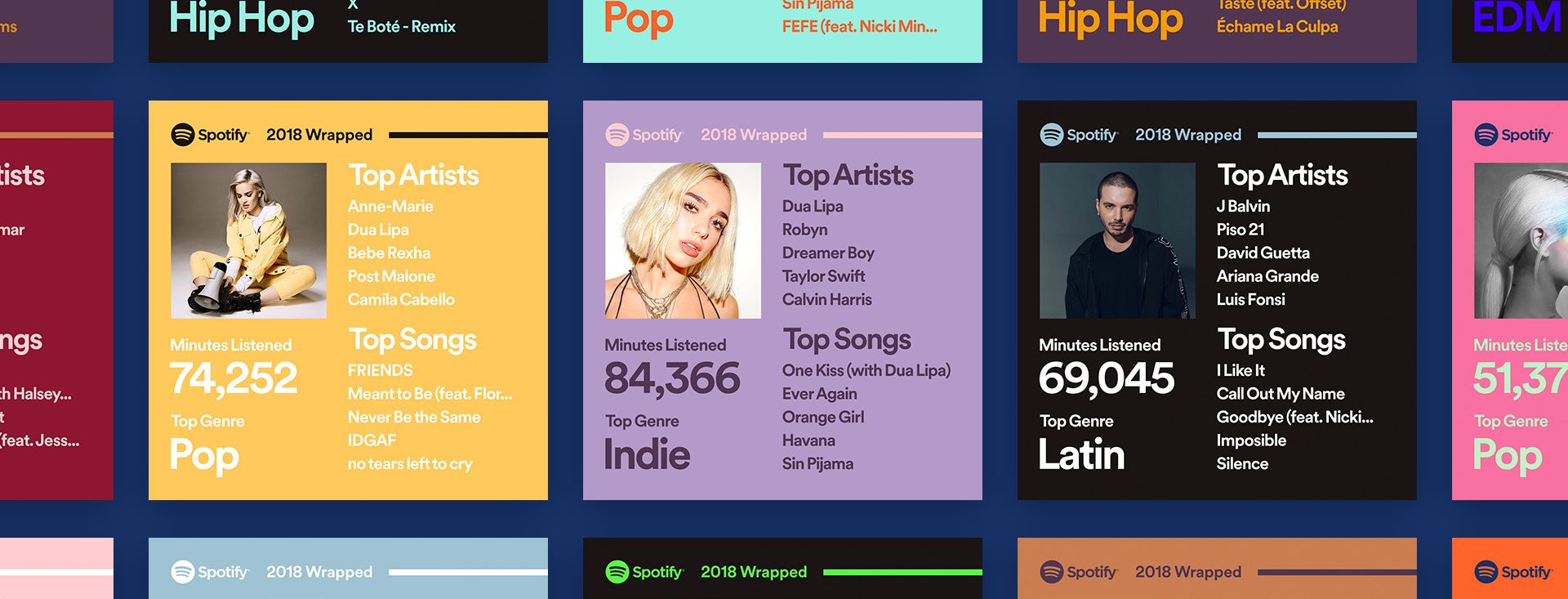library("jsonlite")
library("tidyverse")
library("xml2")
library("RCurl")
library("scales")
library("purrrlyr")
plays <- fromJSON("data/music-data-2018.json")If your social media feed is anything like mine, you probably see a lot of posts like this toward the end of the year.

It can be fun to see what kind of music other people like and to share your own music tastes. It’s also a great advertisement campaign for Spotify (see their nice logo in the top left of these graphics).
The only problem for me is that I’m not a Spotify user, so when I try to open my #2018Wrapped data, I am greeted with a very nicely packaged empty box. Fortunately, as I wrote about in my last post, I log all of my music streaming using a free, open-source service called ListenBrainz. I am going to use that data to create my own end-of-year music graphic similar to the ones posted by my friends who use Spotify. I’m doing this project in R for a couple of reasons. First of all, I kind of like R. Honestly this wasn’t the case a few years ago. It has tons of great stats tools, but a lot of things are very much designed for statisticians. I’m only interested in my activity from 2018, so I will filter my dataset down to only the entries with a timecode in 2018. That’s a lot of music! How was that listening distributed over time? We can use this data to answer some pretty easy questions. For example, who were my top artists in 2018? I can also do something similar to find my top tracks for the year. I listen to a lot of Charli XCX, so this list doesn’t really have a lot of variety (though Charli is absolutely one of the most versatile artists in pop today). Let’s filter the results to only show one song per artist. ListenBrainz also logs the release name, so it’s pretty easy to compile a list of my top albums. Let’s say I just want to know which albums from the last year I streamed. Initially I considered a brute-force approach to this problem; however, it does not seem a good use of resources to get the length for every single song. Instead I’ll write a function to grab lengths for songs… …and sample 100 of my streams. This gives me a reasonable mean length. Which I can use to estimate the total for the population. Observation: the top quartile of artists make up the vast majority of my streams this year. Conclusion: This is a good time to use a sample again.The Data
stamp <- as.numeric(as.POSIXct("2018-01-01", format = "%Y-%m-%d"))
recentPlays <- plays[plays$timestamp >= stamp, ]
recentPlays <- as_tibble(recentPlays[
c("artist_name", "track_name", "release_name", "timestamp")
])
nrow(recentPlays)[1] 13226recentPlays$date <- as.POSIXct(recentPlays$timestamp, origin = "1970-01-01") %>%
as.Date()
recentPlays %>%
ggplot(., aes(format(date, "%Y-%U"))) +
geom_bar(stat = "count") +
labs(x = "Week", title = "Tracks streamed per week.") +
theme(
axis.text.x = element_text(angle = -90, hjust = 0),
panel.border = element_blank(),
legend.key = element_blank(),
panel.background = element_blank(),
plot.background = element_rect(fill = "transparent", colour = NA)
)
Top Artists
artist_name n Charli XCX 870 Carly Rae Jepsen 427 Ariana Grande 311 Kacey Musgraves 277 Marina And The Diamonds 223 Lady Gaga 215 Top Songs
artist_name track_name n SOPHIE Immaterial 41 Charli XCX No Angel 40 Charli XCX I Got It (feat. Brooke Candy, CupcakKe and Pabllo Vittar) 36 Charli XCX Focus 34 Charli XCX Lucky 33 Top Albums
topAlbums <- recentPlays %>%
group_by(artist_name, release_name) %>%
count(sort = T)
topAlbums %>% head()artist_name release_name n Charli XCX Pop 2 296 Kacey Musgraves Golden Hour 247 Carly Rae Jepsen Emotion (Deluxe) 191 Marina And The Diamonds Electra Heart 179 Charli XCX Number 1 Angel 153 Ariana Grande Dangerous Woman 144 getAlbum <- function(row) {
mburl <- sprintf(
'https://beta.musicbrainz.org/ws/2/release/?query=artist:%s+release:%s+AND+status:official+AND+format:"Digital%%20Media"&inc=release-group&limit=1',
curlEscape(row$artist_name),
curlEscape(row$release_name)
)
Sys.sleep(0.25)
groupData <- read_xml(mburl)
xml_ns_strip(groupData)
release <- xml_find_first(groupData, "//release[@ns2:score=100]")
xml_ns_strip(release)
# If it is empty
if (class(release) == "xml_missing") {
release <- xml_new_document() %>% xml_add_child("")
}
# Go with the earliest release date given.
date <- xml_text(xml_find_first(release, "//date"))
artistId <- xml_text(xml_find_first(release, "//artist/@id"))
df <- data.frame(date, artistId, stringsAsFactors = FALSE)
colnames(df) <- c("date", "artistId")
return(df)
}recentAlbums <- topAlbums %>%
filter(n > 100) %>%
by_row(..f = getAlbum, .to = ".out") %>%
unnest(cols = c(.out))
recentAlbums %>%
filter(str_detect(date, "2018")) %>%
dplyr::select(artist_name, release_name, n, date) %>%
filter(n > 75)artist_name release_name n date Kacey Musgraves Golden Hour 247 2018-03-30 Clarence Clarity THINK: PEACE 119 2018-10-04 SOPHIE OIL OF EVERY PEARL’S UN-INSIDES 119 2018-06-15 Amnesia Scanner Another Life 118 2018-09-07 Troye Sivan Bloom 118 2018-08-31 IDLES Joy as an Act of Resistance. 103 2018-08-31 Minutes streamed
getLengths <- function(row) {
song_stripped <- trimws(sub("\\(.*\\)", "", row$track_name))
mburl <- sprintf(
"https://beta.musicbrainz.org/ws/2/recording/?query=artist:%s+AND+recording:%s&limit=2",
curlEscape(row$artist_name),
curlEscape(song_stripped)
)
# To comply with the rate limit.
Sys.sleep(0.5)
albumData <- read_xml(mburl)
xml_ns_strip(albumData)
length <- xml_integer(xml_find_first(albumData, "//length"))
return(length)
}mins <- nrow(recentPlays) * mean(as.numeric(mean_len)) / 60000
mins[1] 50858.81Top Genre
top_artist_ids <- recentAlbums %>%
group_by(artistId) %>%
filter(!is.na(artistId)) %>%
summarize(Sum = sum(n)) %>%
arrange(desc(Sum))
top_artist_ids %>%
summarize(sum(Sum))sum(Sum) 2294 fetchGenres <- function(row) {
mburl <- sprintf(
"https://beta.musicbrainz.org/ws/2/artist/%s?inc=genres",
row$artistId
)
Sys.sleep(0.25)
groupData <- read_xml(mburl)
xml_ns_strip(groupData)
genres <- xml_text(xml_find_all(groupData, "//genre/name"))
return(genres)
}Creating the graphic
library("ggpubr")
library("png")
library("raster")
myTheme <- ttheme(
colnames.style = colnames_style(color = "white", fill = "#8cc257", linewidth = 0),
tbody.style = tbody_style(
color = "white", linewidth = 0,
fill = "#8cc257"
)
)
bgTheme <- theme(
plot.background = element_rect(fill = "#8cc257", color = "#8cc257"),
panel.border = element_blank(),
)
top_artist_names <- top_artists$artist_name %>% head()
artistTable <- ggtexttable(
top_artist_names,
rows = NULL,
theme = myTheme, cols = c("Top Artists")
) + bgTheme
trackTable <- ggtexttable(
top_songs$track_name,
rows = NULL,
theme = myTheme, cols = c("Top Songs")
) + bgTheme
minutes <- as_ggplot(text_grob(paste("Minutes Listened", toString(round(mins)), "", "Top Genre", toString(topGenres[1, 1]), sep = "\n"), color = "white")) + bgTheme
img <- readPNG("images/albums.png")
im_A <- ggplot() +
background_image(img[1:250, 1:250, 1:3]) +
theme(plot.margin = margin(t = .5, l = .5, r = .5, b = .5, unit = "cm")) +
bgTheme
ggarrange(im_A, artistTable, minutes, trackTable, ncol = 2, nrow = 2)